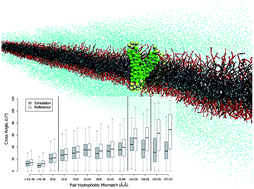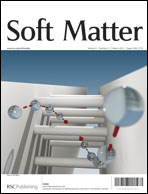Lipid mediated packing of transmembrane helices – a dissipative particle dynamics study†
Abstract
Interactions of transmembrane (TM) helices play a key role in many cell processes. The configuration and cross angle these helices adopt are traditionally attributed to specific residue interactions. We present a different approach, in which specific residues are disregarded, and the role of the membrane in TM helix packing is investigated. We introduce a coarse-grained model of TM helices and obtain their characteristic configurations in the membrane both as a single helix and as paired helices. Our analysis shows that hydrophobic mismatch has a substantial effect in determining not only the tilt angles of TM helices but also the cross angles between helix pairs, for a large range of hydrophobic mismatches. We discuss the origin of this effect as well as the deviations from the common trend. Additionally, we explore the effect of hydrophobic mismatch on the Potential of Mean Force (PMF) between TM helices and discuss the importance of helical geometry in forming crossed configurations. Our observations suggest that hydrophobic mismatch must be taken into account when analyzing configurations of TM helix pairs. Hydrophobic mismatch through its effect on helix tilt can explain many cross-angle distribution features, making the role of specific interactions in determining helix pair configurations less significant.


 Please wait while we load your content...
Please wait while we load your content...